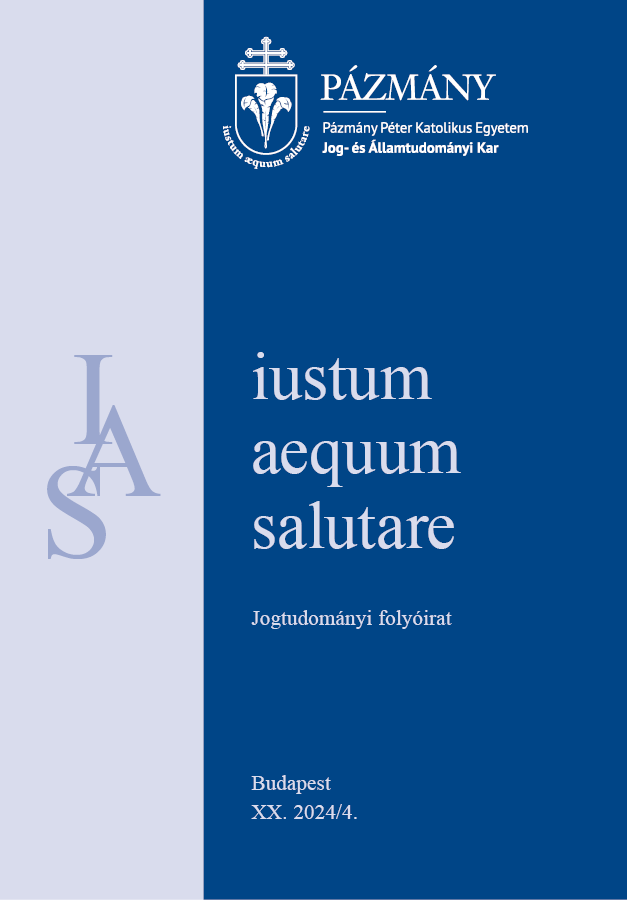The Legal Sources of Lex Laetoria
Abstract
Adults under the age of 25 (minores) had full legal capacity to act but were equally eligible for special legal protection. On the one hand, this was reflected in the substantial legal protection provided by lex Laetoria, from around 200 BC. The statute established an actio poenalis against anyone who deceived a minor. Later, the provisions in the praetorian edict augmented this legal protection: the praetor provided specific legal remedies (exceptio, in integrum restitutio) against the person who deceived the minor.
In this study, we evaluate the primary legal sources exceeding the current trends of secondary literature. The present investigation will not examine the relevant titles of the Digest or papyri texts related to lex Laetoria. We examine various minor legal sources, such as Tabula Heracleensis, lex Irnitana, and fragmentum de formula Fabiana. These are related to how the municipal administration was established (for example, who may be excluded from municipal posts and how duumviri might use iurisdictio) and how the actio legis Laetoriae had a noxal character.
The Pseudo-Paulian texts, as well as the texts in Codex Theodosianus and Iusitinanus, highlight particular cases that all assume a certain level of knowledge: minores were adults under the age of 25 who could enter into a contract. If, however, they were deceived while concluding or performing the contract, they could claim restitutio on the grounds of fraud by the opposing party. Overall, the texts provide support for our abstract knowledge of lex Laetoria but also reveal a network of practices at the micro level.
References
Albanese, Bernardo: Le persone nel diritto privato romano. Palermo, Tipografia Montaina, 1979.
Ankum, Hans: La position juridique du «filius familias» mineur en droit romain classique. In: Hans Ankum – Carlo Augusto Cannata – Robert Feenstra – Y. Le Roy – Johannes Emil Spruit – Peter Weimar (szerk.): Mélanges Felix Wubbe offerts par ses collègues et ses amis à l’occasion de son soixante-dixième anniversaire. Fribourg, 1993. https://doi.org/10.7767/zrgra.1995.112.1.677
Archi, Gian Gualberto: Curatela. In: Francesco Santoro-Passarelli (szerk.): Enciclopedia del diritto XI. Cosa–Delib. Milano, Giuffrè, 1962.
Babusiaux, Ulrike – Baldus, Christian – Ernst, Wolfgang – Meissel, Franz-Stefan – Platschek, Johannes – Rüfner, Thomas: Handbuch des Römischen Privatrechts. Band 1. Tübingen, Mohr Siebeck, 2023. https://doi.org/10.1628/978-3-16-160139-2
Berger, Adolf: Encyclopedic Dictionary of Roman Law. New Jersey, The Lawbook Exchange Ltd., 2010.
Buckland, William Warwick: A text-book of Roman law from Augustus to Justinian. Cambridge, Cambridge University Press, 1921. https://doi.org/10.2307/295908
Bur, Clément: La citoyenneté dégradée. Recherches sur l'infamie à Rome de 312 avant J.-C. à 96 après J.-C. Paris, Université Paris 1 – Panthéon Sorbonne, 2013. https://doi.org/10.4000/books.efr.34897
Cervenca, Giuliano: Studi sulla "cura minorum". I. "Cura minorum" e "Restitutio in integrum". Bullettino dell'Istituto di Diritto Romano "Vittorio Scialoja", Vol. XIV. (1972)
Giuliano Cervenca: Osservazioni sul «curator» della donna minore di venticinque anni. Ivra. Rivista internazionale di diritto romano e antico, Vol. XL. (1989) https://doi.org/10.7767/zrgra.1950.67.1.636
Thénard, Nicolas Cornu – Amirati, S.: « Commentaire du fragmentum de formula Fabiana (P.Vindob. L. 90) et du fragmentum Berolinense (P. Berol. inv. 11753 et 21294) ». In: D. Mantovani – L. Pellecchi (szerk.): Rediscovering the Hidden Structure. 2023.
Crawford, Michael H.: Roman statutes I. London Institute of Classical Studies, University of London, 1996.
Di Salvo, Settimio: Lex Laetoria. Minore età e crisi sociale tra il III e il II a. C. Pubblicazioni della Facoltà di Giurisprudenza dell'Università di Camerino. Napoli, Jovene Editore, 1979. https://doi.org/10.2307/299578
Ellart, Carlos Sánchez-Moreno: Lex Irnitana In: Roger S. Bagnall – Kai Brodersen – Craige B. Champion – Andrew Erskine – Sabine R. Huebner (szerk.): Encyclopedia of Ancient History. Blackwell Publishing, 2012. https://doi.org/10.1002/9781444338386.wbeah13166
Erdődy, János: Protected by Lex Laetoria: Two Papyri of Roman Egypt and Their Effect on Roman Law. Journal on European History of Law, Vol. 13. (2022)
Erdődy, János: Quod cum minore gestum esse dicetur, animadvertam. Bemerkungen zu den minores, denen im Rahmen der lex Laetoria Schutz gewährt wird. Pázmány Law Review, Vol. VII. (2022) https://doi.org/10.55019/plr.2020.1.87-97
Frederiksen, M. W.: The Republican Municipal Laws. Errors and Drafts. The Journal of Roman Studies, Vol. LV., N. 1/2. (1965) https://doi.org/10.2307/297439
Giovannini, Adalberto: Die Tabula Heracleensis. Neue Interpretationen und Perspektiven. Teil II: Die lex Iulia municipalis. Chiron. Mitteilungen der Kommission für Alte Geschichte und Epigraphik des Deutschen Archäologischen Instituts, Vol. XXXVIII. (2008) https://doi.org/10.34780/r712-ik1c
Girard, Paul Frédéric: Textes de droit romain. Tome I. Paris, Dalloz, 71967.
González, Julián – Crawford, Michael H.: The Lex Irnitana. A New Copy of the Flavian Municipal Law. The Journal of Roman Studies, Vol. LXXVI. (1986). https://doi.org/10.2307/300371
Janzsó, Miklós: Tabula Heracleensis. Bevezetés, Fordítás. In: Janzsó Miklós – Szabó Ádám Ágoston (szerk.): Városi törvények a római köztársaság utolsó századából. Szeged, 2009. https://doi.org/10.14232/phd.10471
Kaser, Max: Das römische Privatrecht. Bd. 1. Das altrömische, das vorklassische und klassische Recht. Handbuch der Altertumswissenschaft. München, C. H. Beck, 21971.
Kaser, Max: Über Verbotsgesetze und verbotswidrige Geschäfte im römischen Recht. Österreichische Akademie der Wissenschaften, Philosophisch-Historische Klasse. Wien, Verl. d. Österr. Akad. d. Wiss., 1977. https://doi.org/10.2307/299077
Kaser, Max – Knütel, Rolf: Römisches Privatrecht. Kurzlehrbücher für das Juristische Studium. München, C. H. Beck, 2014. 20. Aufl. https://doi.org/10.17104/9783406745928
Knothe, Hans-Georg: Die Geschäftsfähigkeit der Minderjährigen in geschichtlicher Entwicklung. Frankfurt–Bern, Peter Lang, 1983.
Kunkel, Wolfgang: Untersuchungen zur Entwicklung des römischen Kriminalverfahrens in vorsullanischer Zeit. Abhandlungen der Bayerischen Akademie der Wissenschaften, Philosophisch-Historische Klasse. München, Verl. d. Bayer. Akad. d. Wiss., 1962. https://doi.org/10.2307/293519
Metzger, Ernest: Agree to Disagree. Local Jurisdiction in the Lex Irnitana. In: Andrew Burrows – David Johnston – Reinhard Zimmermann (szerk.): Judge and Jurist. Essays in Memory of Lord Rodger of Earlsferry. Oxford, Oxford University Press, 2013. https://doi.org/10.1093/ACPROF:OSO/9780199677344.003.0020
Mommsen, Theodor: Iudicium legitimum. Zeitschrift der Savigny-Stiftung für Rechtsgeschichte. Romanistische Abteilung, Vol. XII. (1892) http://dx.doi.org/10.7767/zrgra.1892.12.1.267
Mueller, Martin E.: The Date of the Tabula Heracleensis. The Classical Journal, Vol. VI., N. 60. (1965)
Musumeci, Francesco: L'interpretazione dell'editto sui minori di 25 anni secondo Orfilio e Labeone. In: Silvio Romano (szerk.): Nozione, formazione e interpretazione del diritto dall'età romana alle esperienze moderne. Ricerche dedicate al Professor Filippo Gallo. II. Napoli, Jovene, 1997.
Musumeci, Francesco: Protezione pretoria dei minori di 25 anni e ius controversum in età imperiale. Pubblicazioni della Facoltà di Giurisprudenza, Università di Catania. Torino, Giappichelli, 2013.
Oxford Latin Dictionary. Oxford, Clarendon Press, 1968.
Pfaff, Leopold – Hofmann, Franz: Fragmentum de formula Fabiana. Wien, 1888.
Robra, Elisabeth Christine: Die Drittwirkung der Minderjährigenrestitution im klassischen römischen Recht. Berlin, Duncker & Humblot, 2014. https://doi.org/10.3790/978-3-428-54312-0
Rodger, Alan: Jurisdictional Limits in the Lex Irnitana and the Lex de Gallia Cisalpina. Zeitschrift für Papyrologie und Epigraphik, Vol. CX. (1996)
Rotondi, Giovanni: Leges publicae populi Romani. Elenco cronologico con una introduzione sull'attività legislativa dei comizi Romani. Milano, Soc. Editrice Libraria, 1912.
Sanfilippo, Cesare: Istituzioni di diritto romano. Rubbettino Editore, 102002.
Schulz, Fritz: Classical Roman Law. Oxford, Clarendon Press, 1951.
Senn, Félix: Leges perfectae minus quam perfectae et imperfectae. A. Rousseau, 1902.
Siklósi, Iván: Római magánjog I. Budapest, ELTE Eötvös, 2021.
https://doi.org/10.33112/nm.10.1.14
Wacke, Andreas: Zum Rechtsschutz Minderjähriger Gegen Geschäftliche Übervorteilungen. Tijdschrift voor Rechtsgeschiedenis, Vol. 48. (1980) https://doi.org/10.1163/157181980x00019
Wolf, Joseph Georg: Die Lex Irnitana. Ein römisches Stadtrecht aus Spanien. Texte zur Forschung. Darmstadt, WBG, 2011. https://doi.org/10.1524/hzhz.2013.0133
Von Savigny, Friedrich Karl: Von dem Schutz der Minderjährigen im römischen Recht, und insbesondere von der Lex Plaetoria. In: N. N. (szerk.): Vermischte Schriften, Bd. 2. Berlin, 1850.
Copyright (c) 2024 Erdődy János

This work is licensed under a Creative Commons Attribution 4.0 International License.


